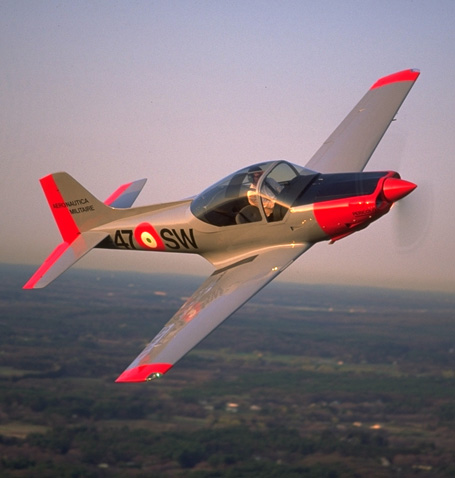Why I Fly a Phony Warbird
![]()
Why I Fly a Phony Warbird |
|
by Stephan Wilkinson
This article appeared in the July 1992 issue of Pilot magazine in England.

As I stood on the ramp flicking motes off my Falco's brand-new Italian Air Force paint job, a dour-looking airport hanger-on paced slowly around the airplane. "That's terrible," he said. "Terrible."
"Huh?" I stopped flicking.
"The roundels. They're all out of proportion." He shook his head grimly.
"They're the insignia of the Republic of Kiribati, and they're correct." I growled.
"Nah, my parents were Italian," he said. "I know what they are, and I take these things seriously."
I hate people who take things seriously. Life's too short, and then you die. Though he was correct in identifying the pizza-shop symbols, I had never intended the Falco's mock-Italian paint job to be an accurate replication of anything. (Besides, the otherwise-faultless painter had misunderstood my instructions and made the diameter of the roundel's green central disk what I'd intended to be its radius. Someday I'll fix it.)
No Falco ever served with an Aeronautica Militaire of any sort, though its big metal brother, the SIAI-Marchetti SF-260, was inducted into a number of air forces as a trainer and even an occasional counterinsurgency weapon. But I'd tired of seeing Falcos in various shades of civilian red and white with zoomy stripes. (I hate stripes on airplanes almost as much as I do humorless people. Stripes are intended to fool the eye into thinking a shape is something it isn't, which may be necessary on a Cessna but doesn't flatter a Falco.)
I think I started to make the decision the day I jokingly asked the FAA inspector if I could put the mandatory experimental labels in Italian, since the Falco was an Italian design. "Absolutely not," he said coldly. "They have to be in English." Well excuuuuuuse me.
Then, one day my wife, a pilot too, regarded the airplane in its grim khaki primer and industrial-gray fiberglass cowl and said, "I know it isn't painted yet, but it looks neat the way it is--sort of arrogant." That did it. I got out some monographs I'd collected during a visit to the Piatgio factory in Genoa, studied some photos of ungainly P.166s and marginally more attractive P.148/149s, and set to sketching .
The result was a Porsche Guards red and national fleet gray paint scheme the machismo content of which I rationalize by telling people, "The Italian air forces never hurt anybody, it's not a warbird thing." Haile Selassie would disagree, but over here, we continue to tell jokes about how it's impossible to buy a used Italian army rifle. And one of the funniest Italian airplanes ever depicted was cartoonist Bruce McCall's Caproni-Moroni C2 Scud, a double-ended fighter with a radial engine at each end and a central cockpit with a swivel seat and dual controls, so the airplane could instantly reverse direction with each change in the country's allegiance. "A remarkable feature of the plane, considering its fighter designation," the accompanying text read, "was its total lack of armament. The designers successfully resisted all attempts to ruin its unbroken lines with ugly guns." Which is why you'll see no phony gunports or hardpoints on my phony fighter.